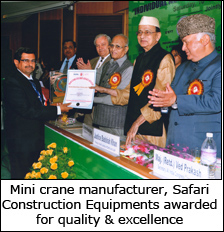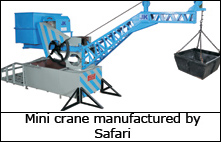 Mini crane manufacturer Safari Construction Equipments Pvt. Ltd received an award for Industrial Excellence from the Indian Economic Development & Research Association (IEDRA) at the 69th National Seminar on ‘Individual Achievements & National Development’ held in New Delhi in November last year. Leading dignitaries, directors of industries and heads of various organisations participated in this seminar.
Mini crane manufacturer Safari Construction Equipments Pvt. Ltd received an award for Industrial Excellence from the Indian Economic Development & Research Association (IEDRA) at the 69th National Seminar on ‘Individual Achievements & National Development’ held in New Delhi in November last year. Leading dignitaries, directors of industries and heads of various organisations participated in this seminar.
Safari Construction Equipment’s Managing Director, Jawahar Kapasi, is the conceptualiser, designer and manufacturer of the popular JK mini crane, which has changed the method for high-rise construction in India. JK Mini Crane lifts construction and building material from ground to the terrace or any other floor where construction work is in progress.
JK Mini Crane has lifting capacity from 150 kg onwards up to 1 ton with various optional features to make work more safer, easier and maintenance free. Mini Crane is also very useful for waterproofing contractors, tile contractors, lifting material in a factory, lifting window grilles, steel, ready mix concrete, waterproofing chemicals, and the whole gamut of construction material.
Check this award winning mini crane video demonstration
 “This award boosts our confidence manifold and gives us a great sense of satisfaction that our work and our mini crane is recognised and valued by industry experts,” Mr. Jawahar Kapasi said, expressing his views on the award.
“This award boosts our confidence manifold and gives us a great sense of satisfaction that our work and our mini crane is recognised and valued by industry experts,” Mr. Jawahar Kapasi said, expressing his views on the award.
Safari Construction Equipments Pvt. Ltd excels in manufacturing innovative and quality construction equipment. The company’s product range includes JK Mini Crane, JK Tough Rider, Mini Batching Plant, Reversible Drum Mixer, Safari Concrete Mixer, Builder Hoist, Tremix De-watering System and other miscellaneous construction equipment.
Find more details about Mini Crane here












Congrats 🙂
The crane for lifting heavy loads was invented by the Ancient Greeks in the late 6th century BC.[1] The archaeological record shows that no later than c.515 BC distinctive cuttings for both lifting tongs and lewis irons begin to appear on stone blocks of Greek temples. Since these holes point at the use of a lifting device, and since they are to be found either above the center of gravity of the block, or in pairs equidistant from a point over the center of gravity, they are regarded by archaeologists as the positive evidence required for the existence of the crane.